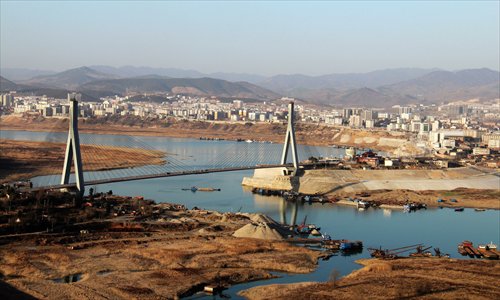Flattening every hill

Li Tieshuan lives near a construction site on the outskirts of Shiyan, in Central China's Hubei Province. Ever since the government started flattening the hills around him, he has had to bring his clothes in at night before the trucks come by in the morning, spreading dust in their wake.
"Just standing here for a while leaves you covered in white dust. When I first settled down here, all these hills were covered with trees. Now the hills have all been flattened," Li said in a China National Radio (CNR) report.
Shiyan is famous for it car manufacturing industry, and is known as the "City of Automobiles."
To boost the development of this industry, the city flattened 33 square kilometers of hills in 2012 as a part of project to explore an economic and technical development zone, and attracted a total of investment of 17 billion yuan ($2.7 billion), according to the city's official website.
In 2013, as the city aims for a further 20 billion yuan in investment, 86 square kilometers of hills on the west and east sides of the city will be flattened. The area that the government plans to level is almost as large as the original downtown area, according to a recent CNR report.
The project has given local industry a boost and increased investment, but it's clear to villagers like Li that the environment has been paying a high price.
Hidden price tag
The blinding dust is not the only problem that concerns the villagers living around Shiyan. They are also worried that the continuous construction and demolition could make their houses collapse.
"The glass in my window was shattered the other day when there was an explosion nearby," an anonymous villager said in the CNR report.
Shiyan, as one of the water sources for the South-to-North Water Diversion Project, has abundant water resources.
However, since the government started to flatten hills around the city a couple of years ago, previously full rivers became dried-up empty husks for most of the year, while mudflows began to occur more frequently during rainy seasons.
The Maota River crosses through Shiyan and passes through Bailang village from west to east. The river previously brought water resources and fruitful harvests for the villagers, but last year the river became a raging torrent that turned the village into a submerged sea.
"All our houses were flooded. The water level was as high as my chest. We had never seen such huge flood before," another villager told CNR.
Walking along the river bank, piles of rock and sand could frequently be seen silted up beside the riverbed, the CNR report said, as the city's economic development zone took shape beside the river.
Dodging assessments
Liu Hongxing, an official from the Hubei Provincial Department of Environmental Protection, told CNR that the department "hadn't received any materials concerning the environmental assessment of the project undertaken in Shiyan."
"I think such a huge project should be well-planned before construction work begins. It is hard to say how much influence it might have on the local environment if you flatten one hill or two, because the effect on an eco-system can be difficult to judge," said Liu.
The environmental protection bureau of Shiyan later confirmed that the project had not gone through any environmental assessment process.
Wang Chunming, a deputy director of the bureau of land and resources of Shiyan said in the CNR report that the project was approved by the provincial department.
"Environmental assessments for construction projects are a compulsory requirement," Wu Xinmu, a professor at the Wuhan-based Hubei University, told CNR.
Wu added that although such assessments are required by law, the administration of the process was often neglected by local authorities.
"Local authorities always emphasize their achievements in their careers as officials," said Wu, adding that the local economy's growth is an important yardstick when evaluating such achievements.
Master plan needed
Shiyan is not the only city that has sought economic development by flattening hills in recent years.
In December, Lanzhou, the capital of Gansu Province, invested 70 billion yuan to flatten 700 barren hills to reshape the city. Since April, Yan'an in Shaanxi Province has been implementing a plan to build a new township in its surrounding gully area which is as twice as large as the city's current area.
Many cities are enthusiastic when it comes to exploring extra land for further development, but overall assessments of the environmental cost of these projects is needed, as is guidance from higher levels of governments, Hou Jingling, a researcher from the Institute for Urban and Environmental Studies with the Chinese Academy of Social Sciences, told CNR.
"Urbanization should not be a phenomenon that results in urban clusters, with oversized cities connecting to another. We should leave some spaces for the nature, for the earth to breathe," Hou warned.
Hou said that this habit of flattening hills to develop extra land was mainly caused by the lack of a national long-term plan on ecological development.
Professor Wu Xinmu, however, said he believes it's more important to shift the focus of local governments from economic growth to sustainable development.
"If in the future the central government introduced indices that measured the state of the local environment, people's feelings, social and cultural development as well as other yardsticks when evaluating the performance of officials, the outcomes would be very different," Wu said.
China National Radio - Global Times